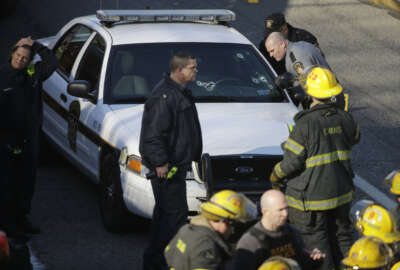
On Memorial Day, the old ones remember the young ones
Within a decade, probably all of the veterans will be gone and with them misty recollections of those who didn't come home alive.
The living, those who survived armed conflict, help us to remember. Many memorable war-related days mark the calendar — D-Day, Pearl Harbor Day, Veterans Day, Armistice Day. Somehow Memorial Day encompasses them all. In the Rockville, Maryland, parade, a local survivor of the Pearl Harbor attack waves from the back seat of a convertible. Or did the last time I watched. Contingents representing conflicts since march by in this and many parades. “We made it,” they seem to say. But we’re marching not for ourselves but rather for the ones who didn’t.
Some battle survivors never fully leave behind that awful moment from the past. Just a month ago, Navy people placed an the ashes of retired Master Sergeant Raymond Haerry into the submerged wreck of the USS Arizona, on which Haerry was serving that day. Before his death in 2016, he’d expressed a wish to be interred with his long-ago shipmates.
My aunt, 94, was attending a Redskins game at Griffith Stadium on Pearl Harbor Day. Before the announcements telling various military personnel in attendance to return to their duty stations, it was just a December Sunday. She still remembers how people sat up and wondered what was going on.
Direct memory of World War II is fading. Within a decade, probably all of the veterans will be gone and with them misty recollections of those who didn’t come home alive. Thirty-some years ago I carpooled to work with a colleague in his mid-60s. He would recall as a boy in Scio, Ohio, seeing parades in which bearded, very old Civil War veterans appeared.
War, for better or worse, seems to have changed for good. The last half-million-man (and woman) mobilization for the U.S. was Operation Desert Storm, and that only lasted a few tense weeks. Coalition forces’ deaths numbered 341 troops killed, 776 wounded. By contrast, the United States had several million troops in England in preparation for D-Day of Operation Overlord — the scale and confusion of which still produces awe. More than 4,000 allied troops died just on the first day, with Germany having roughly equal losses.
World War I still stands, almost mythically, as the violent midwife of the modern world, sweeping away monarchies and empires of old. In many ways we’re still living with its aftermath. Sometimes it takes a century. Four thousand Americans remain missing in action from the Great War, and many of their service records were lost in the great fire at the Federal Personnel Records Center in 1973. But, as my interview with historian Robert Laplander shows, people are still vitally interested in World War I. Luckily other records, such as those recording burials, help reconstruct the outlines of those lives. Laplander convinced the Navy to add the name of Baltimore’s Herbert Renshaw, apparently the first U.S. naval casualty of World War I, to the Lost at Sea memorial wall in Brookwood, England. Low resolution images of Renshaw freeze a young face in time. Now, a face and name remembered.
Copyright © 2025 Federal News Network. All rights reserved. This website is not intended for users located within the European Economic Area.
Tom Temin is host of the Federal Drive and has been providing insight on federal technology and management issues for more than 30 years.
Follow @tteminWFED






